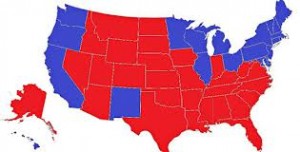 Suppose President Obama wins all of the electoral votes from (1) all of the Northeastern states except New Hampshire; (2) Maryland, Delaware, the District of Columbia, and Virginia; (3) all of the states that border on the Pacific Ocean except Alaska; and (4) New Mexico, Colorado, Minnesota, Illinois, and Michigan. Assume also that Governor Romney wins all of the electoral votes in the remaining 30 states. The results? A 269 to 269 tie, in terms of electoral votes.
Suppose President Obama wins all of the electoral votes from (1) all of the Northeastern states except New Hampshire; (2) Maryland, Delaware, the District of Columbia, and Virginia; (3) all of the states that border on the Pacific Ocean except Alaska; and (4) New Mexico, Colorado, Minnesota, Illinois, and Michigan. Assume also that Governor Romney wins all of the electoral votes in the remaining 30 states. The results? A 269 to 269 tie, in terms of electoral votes.
What would happen then?
If, when the electors vote on December 17, each elector casts his or her ballot for the candidate each supported, the failure of any candidate to achieve a majority of the votes would be certified on January 6 by the President of the United States Senate, who is, of course, Vice President Joe Biden.
Under the terms of the 20th Amendment to the Constitution, the newly elected House of Representatives, which took office on January 3, will then vote to elect a President. Under the 12th Amendment, Congress is required to choose from the three candidates with the highest total of electoral votes from among those receiving electoral votes. Since under this scenario, only Romney and Obama receive electoral votes, the House would have to choose either Romney or Obama.
Under the terms of the Amendment, each state has a single vote, which is determined by how a majority of that state’s Representatives vote. This means that both Alaska and California would have the same one vote, and 26 votes would be necessary to elect a president.
Because of the 20th Amendment (adopted in 1933), those who vote would be the individuals who were elected to the House of Representatives in November 2012. Unlike the situation in 1800 and 1824, the only two times that the House has actually selected the president, the outgoing Congress no longer chooses the President.
Were the current members of the House of Representative voting, the line-up of Republicans and Democrats would clearly favor Gov. Romney, since the Republican Party currently controls 33 state delegations in the House compared to 15 by the Democrats, with two states evenly divided. Although anything can happen in November’s election, it seems unlikely that the Republican Party will control fewer than 26 state delegations in the new Congress.
The 12th Amendment also contains a quorum requirement that dictates that representatives from at least two thirds of the states (currently 34 states) have to be present and voting for the election to be valid. In theory, one political party could prevent the election of a president by boycotting the House vote, but that strategy would work only if the boycotting party included in its ranks the entire Congressional delegations of 17 states.
That is unlikely to happen; in the current Congress, the Republicans unanimously control only 9 state delegations and the Democrats only 7. Hence, if all the House Democrats were to boycott the election, Romney would be elected by a vote of 43 states to none. Similarly, if all the Republicans were to absent themselves from the House chamber, Obama would win by a vote of 41-0. In either case, the quorum requirement would be met.
While the House of Representatives is choosing the new President, the Senate is charged by the 12th Amendment with electing the Vice-President from the top two finishers. In this election, each Senator gets one vote (and thus, unlike in the House, there is no direct voting by state). The current Senate line-up of 51 Democrats, 47 Republicans, and 2 (Democrat-leaning) independents would point toward the election of Joe Biden over Paul Ryan. Of course, that balance could change as a result of the November 2012 elections.
If by chance the vote splits 50 to 50 between the two candidates, Senate President Joe Biden (who will still be Vice President until January 20, 2013, no matter what happens in the fall election) could then vote (presumably for himself) to break the tie. If the House proved unable to elect a new president by January 20, the new Vice-President would assume the office of President until the House finally made a decision.
It is, however, possible that a 269-269 deadlock on November 6 could be broken before the ballots are counted on January 6, if either an Obama or Romney elector were to decide to cast his or her vote for the other candidate.
Can electors do that? The short answer is yes. Although electors pledge to vote for the candidate that they are listed as supporting on state ballots, nothing in the Constitution requires them to cast their vote consistent with their listing on the November ballot.
Although 29 states and the District of Columbia have laws that appear to require electors to vote for the candidates for which they are pledged, only a minority of these states impose a penalty on electors who vote for other candidates, and only the Michigan and Utah statutes purport to nullify the stray vote and provide for the appointment of a replacement elector. Moreover, it is widely believed by constitutional scholars that such state laws are an unconstitutional interference with the federal election process.
Wisconsin is among the states that have such a statute, which can be found at Wis. Stat. § 7.75. This statute provides only that electors are required to vote for the candidate to whom they are pledged unless the candidate is deceased at the time of the vote or that both the president and vice-president are residents of Wisconsin. (The 12th Amendment prohibits electors from casting both their votes for candidates from their own state.) The Wisconsin statute, however, imposes no specific penalty on an elector who violates the terms of § 7.75. Some jurisdictions do impose fines on disloyal electors, and in a few states, the departure is treated as a criminal offense.
This phenomenon—electors casting ballots for candidates other than the one to whom they pledged their support–has happened more frequently in the past than most Americans realize. In 18 of the 55 United States Presidential elections since 1789, at least one elector has either cast a vote for a Presidential or Vice-Presidential candidate to which he was pledged or else refused to cast his or her vote altogether.
The mid-twentieth century was a time when electors acted independently with particular frequency. In the eight Presidential elections between 1948 and 1976, defecting electors cast ballots in six different elections.
Even though disloyal electors have been a somewhat regular occurrence, there is very little evidence that electors who have voted for someone other than the candidate to whom they are pledged have done so because they were trying to help a different major candidate secure election.
The only example of an elector doing this came in 1796, when the Constitution’s original plan for the Electoral College was still in effect. Under the original Article II of the Constitution, there was no separate balloting for President and Vice-President. Instead, each elector cast two votes, and the candidate with the largest number of votes became the President and the runner-up became the Vice-President, so long as their vote totals were equal to a majority of the number of electors voting.
(Otherwise, the House would choose the President from the five top vote getters, and after a president was chosen, the losing candidate with the largest number of electoral votes would become Vice-President. There were also provisions that allowed the House and Senate to select a President or a Vice-Present when two candidates tied for the most electoral votes. That, of course, is what happened in the 1800 election.)
In 1796, Samuel Myles, a Federalist elector from Pennsylvania, cast one of his two votes for the Democratic-Republican presidential candidate Thomas Jefferson and apparently did not vote for his own party’s principal candidate, John Adams. Myles’ betrayal of his constituents didn’t end up making a difference as Adams was elected President anyway.
However, Adams’ margin of victory over Jefferson was only three electoral votes, so it is easy to imagine a scenario where Myles’ vote could have made a difference. (Jefferson, as runner-up in the presidential election, became the Vice-President.)
The most common reason from casting a vote for a different candidate appears to have been a desire to express disapproval of the elector’s own party’s choice of a candidate for either President or Vice-President. In nine different elections–1808, 1812, 1828, 1832, 1836, 1896, 1956, 1976, and 1988—one or more electors voted for a different member of their political party, rather than the party’s official candidate.
On two occasions, 1832 and 2000, electors simply abstained from voting for their party’s candidate (or anyone else). In 1820, William Plumer, a Democrat-Republican elector from New Hampshire, declined to vote for his party’s candidates, incumbent President James Monroe and Vice-President Daniel Tompkins. Plumer instead voted for his friend, Secretary of State John Quincy Adams for President and United States Ambassador to Britain, William Rush as Vice-President, even though neither Adams nor Rush were candidates for those offices. Although Plumer later claimed that he did this so as to ensure that George Washington remained the only man unanimously elected President of the United States, it seems more likely that the former Federalist Plumer was dissatisfied with the continuation of the so-called “Virginia Dynasty” through which the Democrat-Republicans had controlled the presidency since 1801, and instead cast his votes for his fellow former Federalists, Adams and Rush.
In two elections, deviations resulted from the deaths of candidates for President (Horace Greely in 1872) or Vice-President (James Sherman in 1912) after the November election but before the day of the Electoral College vote. (A majority of electors still cast their votes for the deceased candidates in both elections. Both Greeley and Sherman lost their respective elections, so the actual division of their votes was unimportant.)
The variety of motives of dissenting electors can be seen in the elections since 1948. That year, elector Preston Parks of Tennessee cast his electoral vote for South Carolina Governor Strom Thurmond, a fellow conservative Southern Democrat, who had announced his candidacy for the Presidency under the banner of the National States Rights Party. (Parks had already been appointed a Democratic elector before Thurmond announced his third party candidacy, and Thurmond did carry several Southern states.)
Similarly, in 1956, Democratic elector W. F. Turner of Alabama cast his vote for a personal friend Walter Jones, who was an Alabama Circuit Court judge for President and Georgia Governor Herman Talmadge as Vice-President, as a way of protesting the supposed liberalism of Democratic Party nominees, Adlai Stevenson of Illinois and Estes Kefauver of Tennessee.
In 1960, Oklahoma Republican elector Henry D. Irwin cast his ballot for Sen. Harry F. Byrd of Virginia, who was otherwise not a candidate, to protest his dislike of Richard Nixon. (A number of Democratic electors from the South, who were elected as “uncommitted” Democratics, also voted for Byrd, a prominent conservative Democrat.)
In 1972, Roger MacBride, a Virginia elector, cast his Republican ballot for the Libertarian candidate John Hospers, apparently in protest of the economic policies of the Nixon Administration. In 1976, Mike Padden, a Republican elector from Washington State, cast his ballot for Ronald Reagan, instead of his party’s nominee, Gerald Ford, apparently to express his belief that the Republican Party might have won the 1976 election had it nominated Reagan rather than Ford.
In 1988, Margaret Lynch, a Democratic elector from West Virginia, switched her votes so that she voted for Vice-Presidential candidate Lloyd Bentsen for President and Presidential candidate Michael Dukakis for Vice-President. Lynch’s effort was apparently intended to express her dissatisfaction with Dukakis as a candidate. Finally, in 2000, Democratic Elector Barbara Lett-Simmon of the District of Columbia refused to cast her ballot for anyone, as a form of protest over the Supreme Court’s decision in Bush v. Gore which effectively awarded the 2000 presidential election to George W. Bush.
Except for the example of Samuel Myles back in 1796, none of the other elections shed much light on what might happen to break a 269-269 deadlock in 2012. Of course, an elector that decided to vote for someone other than Romney or Obama would not change the outcome. For example, if a Republican elector from Florida decided to cast his vote for Mario Rubio, rather than Romney, Obama would have one more electoral vote than Romney, but he would still lack a majority of the votes, so the election would still go to the House of Representatives, which could now choose between Obama, Romney, and Rubio.
What, if anything, might prompt an Obama or Romney elector in 2012 to switch his or her vote to the other candidate?
One possibility is that an elector might feel that the candidate who received the largest percentage of the popular vote should be president, especially if the gap between the two candidates was more than one or two percentage points. So, for example, if Romney received 53% of the popular vote and Obama received only 46%, with 1% going to minor party candidates, an Obama elector might feel obligated to vote for Romney. Most likely, much of the public would herald such a decision (especially the 53% of the population that voted for Romney).
Another possibility is that some sort of backdoor political deal might be arranged so that an individual elector or his or her state might benefit by the vote switch, although this would have to be done quite delicately in order to avoid a public relations disaster of the first order. Americans would not take kindly to the idea that the presidency had been purchased.
Is any of this likely to happen in 2012? Probably not, but in less than a week we will know for sure.
 In Wisconsin, the Home Rule Amendment to the Wisconsin Constitution grants cities and villages the power to determine their local affairs and government, subject only to the constitution itself and uniform legislative enactments of statewide concern. The Wisconsin Supreme Court has recognized that the Home Rule Amendment serves not only to empower cities and villages, but also to curtail the power of the state legislature to act within the sphere of local affairs. Van Gilder v. City of Madison, 267 N.W. 25 (1936). The job of defining the proper province of constitutional home rule authority (i.e., what constitutes a matter of “local affairs and government” or a matter of “statewide concern”) falls to the courts and, not surprisingly, it is no easy task. Given the concurrent interest of state and local government in many governmental functions, one may argue that such functions cannot be so classified except by arbitrary reasoning.
In Wisconsin, the Home Rule Amendment to the Wisconsin Constitution grants cities and villages the power to determine their local affairs and government, subject only to the constitution itself and uniform legislative enactments of statewide concern. The Wisconsin Supreme Court has recognized that the Home Rule Amendment serves not only to empower cities and villages, but also to curtail the power of the state legislature to act within the sphere of local affairs. Van Gilder v. City of Madison, 267 N.W. 25 (1936). The job of defining the proper province of constitutional home rule authority (i.e., what constitutes a matter of “local affairs and government” or a matter of “statewide concern”) falls to the courts and, not surprisingly, it is no easy task. Given the concurrent interest of state and local government in many governmental functions, one may argue that such functions cannot be so classified except by arbitrary reasoning.

